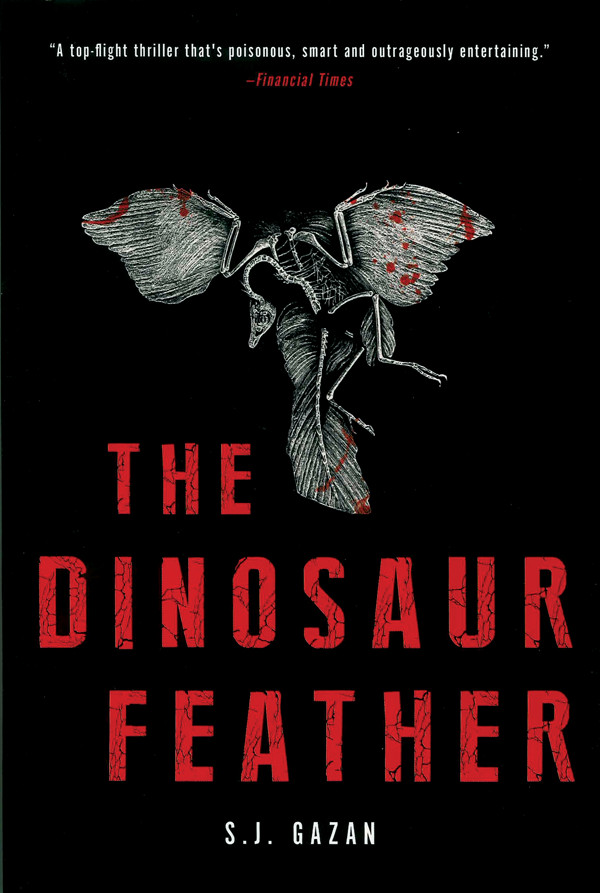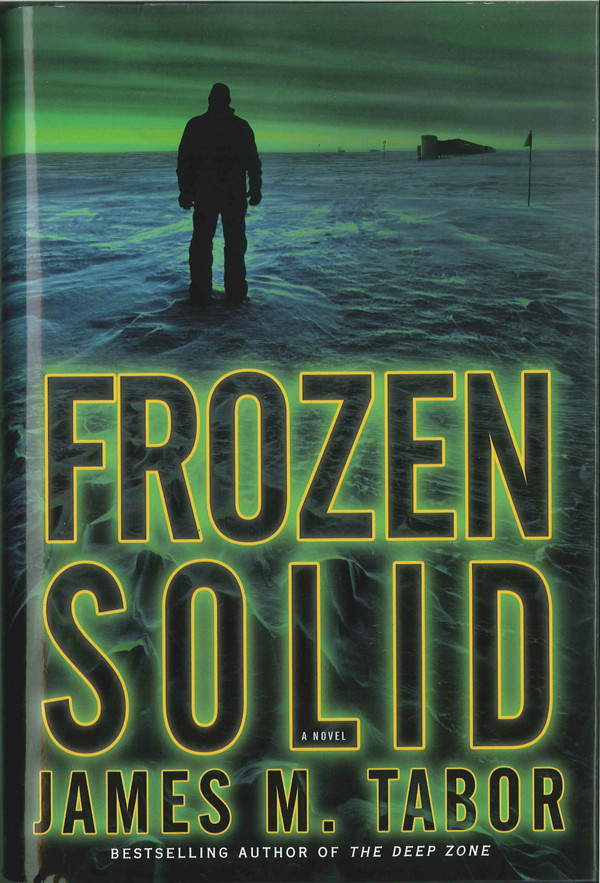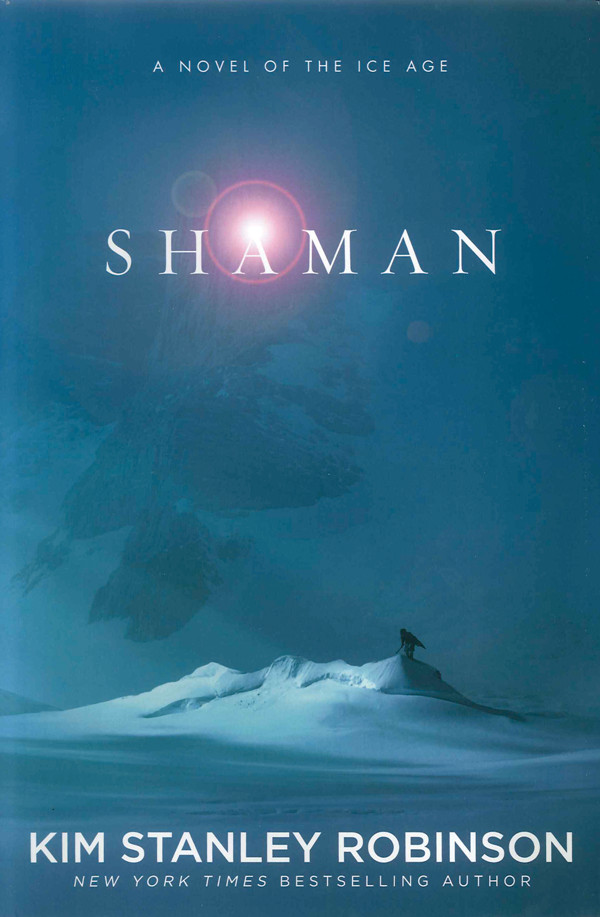
by Callan Bentley Thursday, May 15, 2014
As a science magazine, EARTH usually reviews nonfiction. This month, however, we are bringing you reviews of three recent novels with scientific themes that might make nice additions to your summer reading list. The three novels fall neatly into classic genres — the murder mystery, the high-stakes thriller and the science-infused fantasy — so hopefully there is a little something for everyone. Warning: spoilers follow.

The Dinosaur Feather, by S.J. Gazan with translation by Charlotte Barslund, Quercus, 2013, ISBN: 9781623650667.
The first is “The Dinosaur Feather,” by S.J. Gazan. The novel clearly takes a page from Stieg Larsson’s “The Girl With the Dragon Tattoo” series, which were dark, Scandinavian crime novels featuring grouchy protagonists. “The Dinosaur Feather” is set in Denmark in the cold autumn, and delves briefly into seemingly genre-requisite descriptions of underground sex clubs and body piercings. This novel, thankfully, aspires to more, attempting to immerse the reader in the academic milieu via Anna Bella Nor, a struggling graduate student and single mom, who finds that the murder at the center of the plot is cloaked in an academic controversy.
The controversial issue, whether birds had their origins before or after the emergence of theropod dinosaurs, is the geological tie-in. And Anna is thrown into the middle of it with her thesis research, which focuses on the origins of birds. Just before her doctoral defense, her adviser, a vocal supporter of the “birds are dinosaurs” side of the argument, is killed, and the whodunit begins. Many suspects emerge, as well as a beleaguered detective trying to sort them all out. Overall, the novel is well written, though some of the translation — it was originally written in Danish — felt awkwardly phrased. I did enjoy the complicated backstories of many of the characters, each of whom felt like a complete articulated specimen rather than a loose handful of bones. However, the novel never got to the paleontological payoff that the title (and cover, a blood-spattered Solnhofen Archaeopteryx) seemed to imply — the dinosaur feather doesn’t serve as murder weapon so much as background noise.
Frankly, the controversy is not especially compelling, nor is it presented in tantalizing fashion. The antagonists on either side of the argument (two rival professors at different universities) are both schmucks in their own repellent ways. Furthermore, the “controversy” itself seems already solved in real life. The feathered dinosaurs coming out of China’s fossil fields have confirmed that feathers preceded flight, and that birds are most likely the descendants of theropods. With this knowledge in mind while reading “The Dinosaur Feather,” the plot will make you roll your eyes.

Frozen Solid, by James M. Tabor, Ballantine Books, 2013, ISBN: 9780345530639.
I liked James M. Tabor’s “Frozen Solid” better, in part because it reminded me of adventure fiction that I read as a teenager. And if you liked Dan Brown’s “The Da Vinci Code,” Michael Crichton’s “Sphere,” or any of the dozens of novels by Clive Cussler, you will probably find “Frozen Solid” enjoyable. As with “The Dinosaur Feather,” the protagonist is a no-nonsense female scientist. Hallie Leland is a microbiologist sent to Antarctica to dive into a subglacial lake and extract a colony of extremophiles. As soon as she gets there, though, people start dying, and it is up to our shrewd heroine to sort out the good guys from the bad.
At its heart, the conspiracy Leland faces is about dealing with human overpopulation on the planet, so “Frozen Solid” presents more current science than “The Dinosaur Feather” does. When you throw in the microbes’ curious metabolism, a bit of human genetics, and the day-to-day grind of life as a scientist at the South Pole, you end up with a thriller that will tickle your scientific interest as much as your adrenal gland.
That said, I have to note that author Tabor is apparently not a geoscientist — nor did he or the editor do much homework. The first major flub comes in the novel’s second sentence, which establishes that February in the novel’s Antarctica is in … winter. Oops. Elsewhere, a character states as fact that, “The whole continent is just frozen ocean miles thick.” Worse, from the biological perspective, the plot turns on the “conjoining” of a virus and a bacterium. Not only is that ludicrous, but in this case it is doubly ludicrous because in Tabor’s world, the bacterium lives inside the virus. Can you forgive these errors for the sake of a ripping yarn? If so, “Frozen Solid” may be for you.

Shaman, by Kim Stanley Robinson, Orbit, 2013, ISBN: 9780316098076.
Finally, I read Kim Stanley Robinson’s new tale of the Ice Age, “Shaman.” Robinson is well known and much celebrated among fans of traditional science fiction, and his “Mars” trilogy garnered him several awards as well as a loyal fan base. In “Shaman,” he recounts several years in the life of Loon, a Cro-Magnon boy living in Pleistocene Europe (though the terms “Cro-Magnon,” “Pleistocene,” and “Europe” never appear in the book). This is an immersive story, told using language that Robinson imagines would have been appropriate to the people of the day. He does not take this so far as to alienate his readers, but far enough to make the dialogue feel a bit foreign and therefore enticing. And, he conveys science with it. When Loon and some compatriots visit a nunatak, a rocky peak poking through an ice sheet, he notes that the “red blocks were smoothed to a polish, with straight lines scoring the polish north and south. There were also crescent breaks, the shape of day three or four of the moon, cut into the rock.” You’ve just heard Loon describe glacial striations and chatter marks, but without the jargon.
The thing I was most struck by in reading “Shaman” was how Robinson conveyed the sense that the Cro-Magnon were just like us — albeit lacking the printed word and more advanced technologies, wearing fur instead of GORE-TEX®, but clearly smart and articulate nonetheless. Much of the novel takes place in the mind of Loon, a teenager on the brink of manhood, training to be his tribe’s shaman. Loon worries and mulls things over, and many of his thoughts and emotions feel all too familiar. He finds love, loses it and then takes great risks to gain it back again. Sounds prosaic, right? But in the course of the tale, he finds food and water, masters fire, deals with an injured leg and manages not to slip on a snowy slope. He also encounters bears, lions and woolly rhinos; forges a tense cooperation with a Neanderthal; finds himself adrift on sea ice; and paints on the walls of a cave. “Shaman” is a slower-paced tale than either of the two modern-day novels above, but that reflects its more elemental simplicity — in the Pleistocene, survival through the winter was dramatic fodder enough.
© 2008-2021. All rights reserved. Any copying, redistribution or retransmission of any of the contents of this service without the expressed written permission of the American Geosciences Institute is expressly prohibited. Click here for all copyright requests.